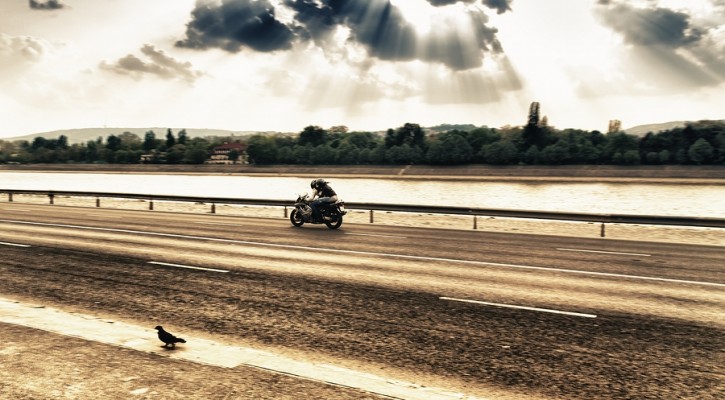
Motorcycles on Ice
March 2, 2015
With snow and ice covering most of the country right now, you wouldn’t expect to see a motorcycle on the road any time soon. Motorcycles aren’t the best vehicle for winter driving. However, with the right gumption, gear and know-how, riding enthusiasts can enjoy their motorcycles in just about any weather.
Here’s how:
Know the Temperature
Knowing exactly how cold your riding climate is will be vital. The temperature you feel walking outside is drastically warmer than the temperature you feel at 60 mph. This chart from rom the National Weather Service can give you some idea of what you are up against.
Remember ATGATT
Wearing All The Gear All The Time is always important. In the winter, wearing all the gear all the time is sure to make things warmer as well. From thick, insulated helmets to wind-blocking motorcycle suits to tough-as-nails riding boots, the very same gear that keeps you safe in the summer is sure to keep you warm in the winter.
Dress for the Part
Because wind has such a high impact on your body temperature, deflecting it is the highest priority. From the head down, every inch of your body needs to be shielded from the elements.
The helmet is your windproof shell for the head. Besides blocking the wind and protecting your noggin from the asphalt, it also provides a thick layer of insulation that’s perfect for keeping warm. You can add to that insulation by incorporating a ski mask, scarf, or bandanna. However, make sure you leave a little room for fresh air to get in or you may run out of oxygen.
For the body, windproof snow gear and leather outer layers are great for cold rides. Layer up with wool, fleece and thermal liners on the inside, and remember to wear a good belt to keep wind from creeping up your back.
Add Heat
This is such a wonderful modern world we live in. These days, motorcyclists can find electric apparel to warm up their wintry rides. Companies such as Aerostich, Gerbing and Widder make electric riding clothes that attach to the bike’s electrical system for wearable heating. There are electric jackets, gloves and vests available. Although you may be tempted begin the electric clothing collection with gloves, the vest actually provides the most warming benefit. Riders say that an electric vest can make the weather more comfortable, allowing them to ride in conditions much colder than they would attempt otherwise.
You can also add heat with good old fashioned hand warmers, which can be stuffed into gloves, pockets and socks. These classic little warmers work great and can last up to 10 hours.
Control Moisture
With all this heavy gear on, you’re sure to get a little hot before hitting the road. Perspiration can have a negative effect on your ability to stay warm once you’re riding. However, wearing the proper underclothes can help with this issue. The outdoor clothing industry includes a large selection of socks and underwear specially designed to wick away moisture. Wool is also great for keeping the heat in while allowing enough air circulation to keep things nice and dry.
Hands and Feet
For the same reason, I like to wear waterproof boots and gloves. I have a roomy pair of boots I press into service with heavy socks during rides that promise cold. If your only riding boots are lightweight and offer neither waterproofing nor room for extra socks, a pair of hiking or similarly heavy boots (especially a pair with insulation) may be a better bet. By the way, wearing your pants outside your boots keeps you much warmer than vice versa.
There are a number of gloves that meet my waterproof, cold-stopping criteria, with two-finger gloves and electric gloves topping the warmth meter — if they allow for a good feel on the controls. Leather for its crash protection, and a firm retention system is also high on my list of desirable glove attributes. Gauntlets that fit snugly over the sleeves of your jacket are essential. Since those sleeves may be fairly bulky, they may require gauntlets that seem awfully large on their own. Lightweight liners worn under the gloves can improve warmth by controlling perspiration and keep your hands comfy at gas stops, etc.
Another effective device for keeping your hands warm are covers that attach to the handlebar and completely enclose the grip area and your hands, such as Harper Hands offered by Chase Harper. These pods are most useful for riders who ride regularly in very cold weather.
Beware of Ice
Watch out for those bridges that freeze before the roads do, and be alert for black ice in shady areas. If you must cross an icy patch or even a suspected one, keep the bike slow, straight and steady. Squeezing in the clutch and free-wheeling across the ice will keep you from applying either too much or too little power to the rear wheel. As a rule, you will be steadier with your feet on the pegs or floorboards than dragging them. Also watch for sand placed in corners to deal with the ice.
If you have the proper gear and avoid the slick spots, riding in cold weather can be as comfortable and fun as riding on warm days. And the investment you make in cold-weather gear simply enhances your investment in your bike.
Remember, winter riding is not for the novice motorcyclist, or for the faint-of-heart. If you’re still a beginner on the bike and are interested in winter riding, then now is the time to begin preparations for next year’s winter adventures.
